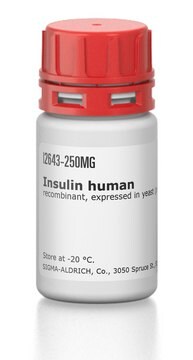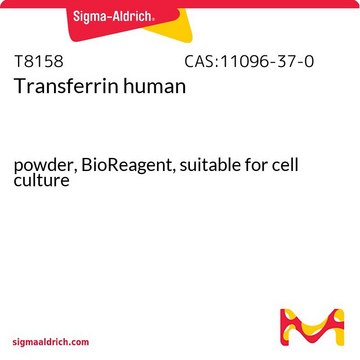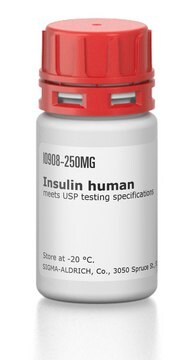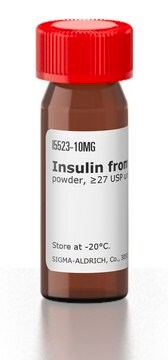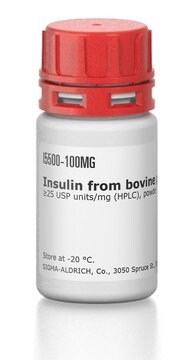I3536
Insulina
recombinant, expressed in yeast, γ-irradiated, suitable for cell culture
Sinônimo(s):
Insulin human
About This Item
Produtos recomendados
recombinante
expressed in yeast
Nível de qualidade
esterilidade
γ-irradiated
forma
lyophilized powder
potência
≥25 USP units per mg
técnica(s)
cell culture | mammalian: suitable
solubilidade
0.01 M HCl: 20 mg/mL, clear, colorless to faintly yellow
nº de adesão UniProt
Condições de expedição
ambient
temperatura de armazenamento
−20°C
chave InChI
PBGKTOXHQIOBKM-FHFVDXKLSA-N
Informações sobre genes
human ... INS(3630)
Procurando produtos similares? Visita Guia de comparação de produtos
Descrição geral
Aplicação
- For adipogenic differentiation assays (in the preparation of medium supplement)
- Incubation of cells for the evaluation of the effects of insulin
- Mass spectrometry (used for the external caliberation)
Ações bioquímicas/fisiológicas
Outras notas
Código de classe de armazenamento
13 - Non Combustible Solids
Classe de risco de água (WGK)
WGK 2
Ponto de fulgor (°C)
Not applicable
Certificados de análise (COA)
Busque Certificados de análise (COA) digitando o Número do Lote do produto. Os números de lote e remessa podem ser encontrados no rótulo de um produto após a palavra “Lot” ou “Batch”.
Já possui este produto?
Encontre a documentação dos produtos que você adquiriu recentemente na biblioteca de documentos.
Os clientes também visualizaram
Nossa equipe de cientistas tem experiência em todas as áreas de pesquisa, incluindo Life Sciences, ciência de materiais, síntese química, cromatografia, química analítica e muitas outras.
Entre em contato com a assistência técnica
